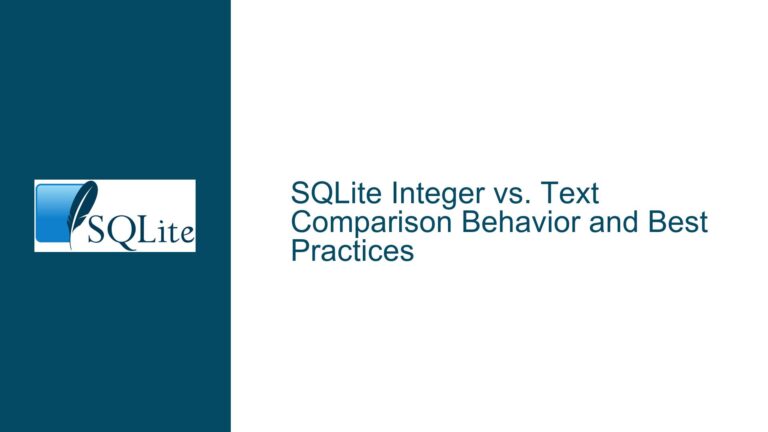Efficiently Joining Multiple Tables in SQLite: Avoiding Repetitive AND Clauses
Issue Overview: Struggling to Join Multiple Tables Without Repetitive AND Clauses
A common challenge in SQLite involves joining multiple tables using primary keys while avoiding verbose AND-based equality checks. Consider a scenario where four tables (T1, T2, T3, T4) are defined with primary keys K1, K2, K3, and K4, respectively. The goal is to retrieve records where all keys match, typically achieved with a query like:
SELECT K1,K2,K3,K4
FROM T1,T2,T3,T4
WHERE (K1=K2) AND (K1=K3) AND (K1=K4);
This approach works but requires repetitive AND clauses, which can become unwieldy as the number of tables grows. The user sought a cleaner syntax to achieve the same result. Initial attempts to use row values (e.g., WHERE (K1,K1,K1) = (K2,K3,K4)) yielded no results, leading to confusion. Further investigation revealed that while row values can simplify syntax, their misuse or misunderstanding of SQLite’s join mechanics often causes unexpected outcomes. The discussion also highlighted performance implications of different approaches, such as implicit vs. explicit joins.
Key pain points include:
- Syntax Overhead: Repetitive
ANDclauses reduce readability. - Row Value Misapplication: Incorrectly structured row comparisons or parameter bindings.
- Performance Pitfalls: Cartesian products from implicit joins, especially when filtering via
WHEREinstead ofJOIN ON.
Possible Causes: Misapplication of Row Value Comparisons and Implicit Join Pitfalls
1. Row Value Syntax Misunderstandings
Row values allow comparing multiple columns in a single expression. For example:
WHERE (K1, K2) = (K3, K4)
is equivalent to:
WHERE K1=K3 AND K2=K4
However, the user’s initial attempt failed because:
- Column Order Mismatch: The row value
(T1K1, T2K1) = (?1, ?2)comparesT1K1to?1andT2K1to?2, which may not align with the intended logic (e.g., matching keys across tables). - Parameter Binding Errors: If parameters
?1and?2are not bound to the correct values, the query returns no results. For instance, binding?1toT1K1and?2toT2K1would only work if those values are explicitly set to match.
2. Implicit Joins and Cartesian Products
When tables are listed in the FROM clause without explicit JOIN conditions (e.g., FROM T1,T2,T3,T4), SQLite computes the Cartesian product of all tables. This generates all possible row combinations, which is computationally expensive. Filtering via WHERE afterward forces SQLite to process this massive intermediate result. For example, four tables with 1,000 rows each would produce 1 trillion rows before filtering—a clear performance disaster.
3. Primary Key Insertion Logic
The user’s schema uses INSERT INTO T1 VALUES (NULL, 'ONE'), which leverages SQLite’s INTEGER PRIMARY KEY auto-increment. However, if inserts into T1, T2, T3, and T4 are not synchronized, their primary keys will diverge. For instance:
T1might have keys1,2,3,4.T2might have keys1,2,3,4.
But if inserts are interleaved or transactional logic is missing, mismatched keys can occur, leading to no matches in queries.
Solutions and Best Practices: Utilizing Explicit JOIN Syntax and Proper Row Value Implementation
1. Explicit JOIN Syntax for Clarity and Performance
Rewrite the query using JOIN clauses to explicitly define relationships:
SELECT T1.K1, T2.K2, T3.K3, T4.K4
FROM T1
JOIN T2 ON T1.K1 = T2.K2
JOIN T3 ON T1.K1 = T3.K3
JOIN T4 ON T1.K1 = T4.K4;
Advantages:
- Readability: Each join condition is isolated, making the query easier to debug.
- Performance: SQLite’s optimizer uses join order and indices more effectively, reducing intermediate row counts.
2. Correct Row Value Usage
Row values are valid in SQLite but require careful implementation:
-- Compare keys across tables
SELECT K1,K2,K3,K4
FROM T1,T2,T3,T4
WHERE (K1,K1,K1) = (K2,K3,K4);
This works but still computes a Cartesian product. To avoid this, combine row values with explicit joins:
SELECT T1.K1, T2.K2, T3.K3, T4.K4
FROM T1
JOIN T2 ON (T1.K1) = (T2.K2)
JOIN T3 ON (T1.K1) = (T3.K3)
JOIN T4 ON (T1.K1) = (T4.K4);
Parameterized Query Fix:
Ensure parameters are bound to the correct columns:
-- Correct: Compare T1K1 and T2K1 to bound parameters
slselAry "SELECT FIRST FROM T1,T2 WHERE (T1K1, T2K1) = (?1, ?2)", sArray(), "Q9c"
Bind ?1 and ?2 to the specific key values you want to match (e.g., 1 and 1).
3. Data Synchronization and Primary Key Alignment
If tables are meant to have synchronized keys (e.g., T1.K1 always equals T2.K2), use transactions to ensure atomic inserts:
BEGIN TRANSACTION;
INSERT INTO T1 VALUES (NULL, 'ONE');
INSERT INTO T2 VALUES (NULL, 'TWO');
INSERT INTO T3 VALUES (NULL, 'NOTEA');
INSERT INTO T4 VALUES (NULL, 'NOTEB');
COMMIT;
This guarantees that all tables receive a new auto-incremented key in the same transaction, ensuring alignment.
4. Indexing and Query Optimization
While primary keys are automatically indexed in SQLite, complex joins benefit from additional indices on frequently filtered columns. Use EXPLAIN QUERY PLAN to diagnose performance issues:
EXPLAIN QUERY PLAN
SELECT K1,K2,K3,K4
FROM T1,T2,T3,T4
WHERE (K1,K1,K1) = (K2,K3,K4);
This reveals whether SQLite is using indices or resorting to full table scans.
5. When to Use Row Values
Row values shine in specific scenarios:
- Composite Key Comparisons:
WHERE (FirstName, LastName) = ('John', 'Doe'); - Batch Updates:
UPDATE Employees SET (Salary, Department) = (SELECT Budget, DeptName FROM Departments WHERE Id = 10) WHERE Id = 5;
Avoid them for large joins due to Cartesian product risks.
By adopting explicit JOIN syntax, aligning primary key insertion logic, and judiciously using row values, developers can write efficient, maintainable SQLite queries. Always validate parameter bindings and leverage SQLite’s optimization tools to ensure queries perform as expected.





